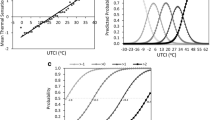Abstract
The study presents a climatic classification based on energy exchanges between man and the surrounding atmosphere. Variables that affect man's heat balance are included in a scheme that produces a single value describing the insulation requirements for maintenance of thermal equilibrium in familiar terms. The approach allows for the interpretation of a computed clo value, derived from standard meteorological data, as a unitary index of the body-environment energy flux. Hourly values were computed using data from 77 meteorological stations across Canada for the months September to April for a 10 year period. Seasonal maps are presented illustrating a marked zonal character and the thermal conditions both for "day-time" and "night-time" hours. The scheme enables classification of climates in quantitative terms with meaningful implications as regards man's behavioural response to climate.
Similar content being viewed by others
References
AULICIEMS, A., DE FREITAS, C.R. and HARE, F.K. (1973): Winter Clothing Requirements for Canada. Climatological Studies No. 22, Environment Canada, Toronto, 80 pp.
BURTON, A.C. and EDHOLM, O.G. (1955): Man in a Cold Environment. Arnold, London, 373 pp.
CHRISTENSEN, E.H. (1953): Physiological valuation of work in Nykroppa Iron Works. In: Symposium on Fatigue. W.F.Floyd and A.T.Welford (eds.), Lewis, London, 95–107.
DUBOIS, E.F. (1927): Basal Metabolism in Health and Disease. Lea and Febiger, Philadelphia.
FORBES, W.H. (1949): Definitions, miscellaneous figures and conversion factors. In: Physiology of Heat Regulation and the Science of Clothing. L.H.Newburgh (ed.), Saunders, Philadelphia, 445–450.
FOURT, L. and HARRIS, M. (1949): Physical properties of clothing fabrics. In: Physiology of Heat Regulation and the Science of Clothing. L.H.Newburgh (ed.), Saunders, Philadelphia, 291–319.
FOURT, L. and HOLLIES, N. (1969): The Comfort and Function of Clothing. Tech. Rept. 69-74-CE, United States Army Natick Laboratories, Massachusetts, 285 pp.
GAGGE, A.P., BURTON, A.C. and BAZETT, H.C. (1941): A practical system of units for the description of the heat exchange of man with his environment. Science, 94: 428–430.
GIVONI, B. (1969): Man, Climate and Architecture. Elsevier, New York, 364 pp.
GREGORCZUK, M. (1968): Bioclimates of the world related to air enthalpy. Int. J. Biometeor., 12: 35–39.
HARDY, J.D. (1949): Heat transfer. In: Physiology of Heat Regulation and the Science of Clothing. L.H.Newburgh (ed.), Saunders, Philadelphia, 78–108.
HAY, J.E. (1970): Aspects of the Heat and Moisture Balance of Canada. Unpublished Ph.D.dissertation, University of London.
LEE, D.H.K. and VAUGHAN, J.A. (1964): Temperature equivalent of solar radiation on man. Int. J. Biometeor., 8: 61–69.
LIST, R.J. (ed.)(1963): Smithsonian Meteorological Tables. Smithsonian Institute, Washington D.C.
MORRIS, M.A. (1955): Thermal insulation of single and multiple layers of fabrics. Text. Res. J., 25: 766–773.
PIERCE, F.T. and REES, W.H. (1946): The transmission of heat through textile fabrics: Part II. J. Text. Inst., 37: T181-T204.
ROLLER, W.L. and GOLDMAN, R.F. (1968): Prediction of solar heat load on man. J. appl. Physiol., 24: 717–721.
SIPLE, P.A. (1949): Clothing and climate. In: Physiology of Heat Regulation and the Science of Clothing. L.H.Newburgh (ed.), Saunders, Philadelphia, 389–442.
TERJUNG, W.H. (1966): Physiologic climates of the conterminous United States: a bioclimatological classification based on man. Ann.Ass.Amer.Geogr., 61: 481–500.
TERJUNG, W.H. (1967): Annual physioclimatic stresses and regimes in the United States. Geogr. Rev., 57: 225–240.
TERJUNG, W.H. (1968): World patterns of the distribution of the monthly comfort index. Int. J. Biometeor., 12: 119–151.
WINSLOW, C.E.A., GAGGE, A.P. and HERRINGTON, L.P. (1939): The influence of air movement upon heat losses from the clothed body. Amer. J. Physiol., 127: 505–518.
Author information
Authors and Affiliations
Rights and permissions
About this article
Cite this article
Auliciems, A., de Freitas, C.R. Cold stress in Canada. A human climatic classification. Int J Biometeorol 20, 287–294 (1976). https://doi.org/10.1007/BF01553585
Received:
Issue Date:
DOI: https://doi.org/10.1007/BF01553585




